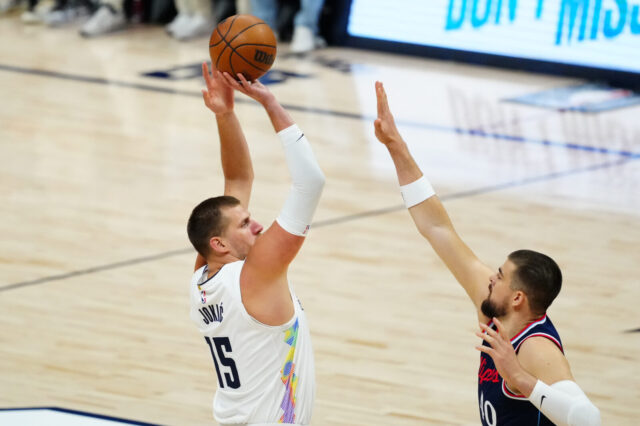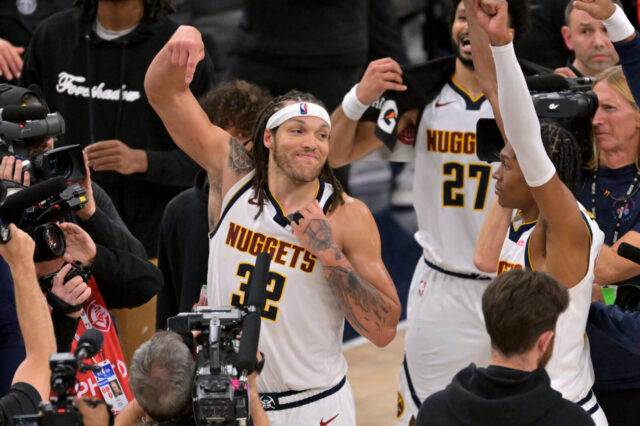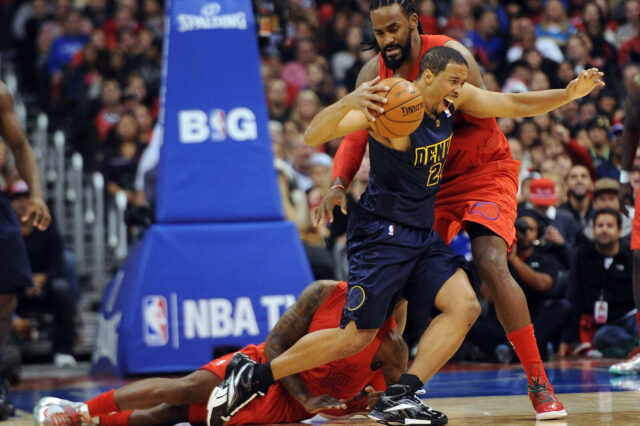About a week ago I broke down just what the Denver Nuggets would have to give up for Oklahoma City Thunder point guard Russell Westbrook. The conclusion? A lot. However, outside of Westbrook, there are several other marquee names rumored to be available on the trade market, or at least their respective teams are willing to pick up the phone and listen. These players include Blake Griffin, Kevin Love and DeMarcus Cousins, among others. For this week, Griffin will be the subject of our analysis. If you missed out on the Westbrook piece, check it out here.
In order to create a baseline for the value that should be expected to be surrendered to acquire a player of Griffin or Westbrook’s caliber we evaluated several “superstar” trades in the past and the package their respective teams received for dealing them. To quantify the value these teams received we looked at the cumulative VORP (value over replacement player) of the trade package. However, an issue arose with VORP not representing the future value of prospects who may be anticipated to have very bright NBA careers but up to the point they were traded they had produced very little (or at all). A prime example of this was the Love to the Cleveland Cavaliers trade where Andrew Wiggins registered a VORP of 0 because he had never played an NBA game at the time of the trade. When considering trades the Nuggets might make this issue is magnified due to the high number of young prospects on the roster who have yet to reach their potential.
To combat this we’ll change our evaluation method slightly. VORP is a similar measure to WAR (wins above replacement) and the good folks over at FiveThirtyEight.com have developed a statistical model for forecasting future WAR of every player in the NBA which they affectionately call CARMELO (Nuggets fans just love that I’m sure). By using their CARMELO system we can take the cumulative average of these young prospects forecasted future WAR and use that as a quantitative representation of their current value in trade packages. For the purpose of this exercise, any player with fewer than three seasons in the NBA will have his value determined by using an average of his projected WAR. The table below is a refresher on the five packages we used as a historical baseline for superstar trades. The trades we used were Carmelo Anthony to the New York Knicks, Chris Paul to the Los Angeles Lakers, Chris Paul to the Los Angeles Clippers, Dwight Howard to the Los Angeles Lakers and the aforementioned Love to the Cavaliers.
| Trade partners | NBA starter | NBA role player | Young role player/prospect | Long shot prospect | Cumulative WAR |
| Nuggets and Knicks | Danilo Gallinari | Raymond Felton | Wilson Chandler | Timofey Mozgov | 10.65 |
| Hornets and Lakers | Lamar Odom | Luis Scola | Kevin Martin | Goran Dragic | 17.82 |
| Hornets and Clippers | Eric Gordon | Chris Kaman | Al-Farouq Aminu | None | 2.23 |
| Magic and Lakers | Arron Afflalo | Al Harrington | Nikola Vucevic | Josh McRoberts | 11.88 |
| Cavaliers and Timberwolves | Thaddeus Young | none | Andrew Wiggins | Anthony Bennett | 7.1 |
The above chart has been adjusted to take the sum of each players average WAR from the two seasons prior to being traded, or in the case of players who were traded prior to playing two seasons, we took the average WAR of their first two years in the NBA (with one exception, for Wiggins and Bennett I used the average of their projected WAR…Bennett still was a negative player despite CARMELO generously having him hit a ceiling of a mediocre NBA talent), The reason for using two seasons of actual WAR as opposed to just the previous seasons' as we did in the Westbrook piece is it will give a more accurate projection of the player's actual perceived value. For example, Wilson Chandler recorded zero WAR last season because he didn't play but he still has value to opposing GMs because of what he did in previous seasons. However, at the same time his health has to be taken into account so by averaging the past two seasons we reduce his overall WAR due to injuries but still quantify his value.
After we throw out the two Chris Paul trade outliers it would seem that a trade for Griffin would take a cumulative WAR of somewhere between 7 and 11. However, a trade for Griffin should in theory cost less than one for Westbrook given that Westbrook is the better overall player and also wasn’t going around punching equipment managers in the face last season. The cumulative WAR from the Westbrook trade proposed in our previous “What would it take to trade for” piece is 9.97 so a package for Griffin should be somewhere between a cumulative WAR of 7 to 9.5.
Luckily, there's been some whispers about a Griffin to Denver trade for sometime, including back last season when the whole equipment manager fiasco happened and the Clippers reached out to Denver about making a deal (or the Clippers begrudgingly answered the phone when the Nuggets came begging for Griffin, depending on whether or not you're getting your info from a reporter on the West Coast). The rumored asking price? Nikola Jokic, Will Barton, Kenneth Faried and Danilo Gallinari.
This content is no longer available.
Strikingly similar to our proposed Westbrook deal but with Jokic instead of Emmanuel Mudiay. That of course is going to blow the whole trade out of proportion. The cumulative WAR for the rumored Griffin to Denver deal is an incredibly high 16 and what’s more is the Nuggets would have also had to take back the headache of Lance Stephenson. Can’t blame the Clippers for trying I guess. Further compounding the issue, now that Stephenson is hoping the Lakers will pay him the vet minimum to come to training camp, the only way this proposed deal could even happen is if J.J. Redick gets added and while he’s a fine player the price is still way too steep, moving on.
The Ringer, of Bill Simmons fame, also took a crack at a hypothetical Nuggets-Griffin deal a month ago, suggesting that Gallinari, Barton and Joffrey Lauvergne would be an adequate package for the talented point forward. Unlike the last trade, this one is good to go as far as salary cap considerations are concerned.
This content is no longer available.
However, the problem with this deal is it’s getting pretty hardball with the Clippers. Call me crazy, but I don’t think any team is going to be trading one of their star players to the Nuggets without getting back one of their touted young prospects (and no Lauvergne doesn’t count). The cumulative WAR isn’t going to shake out on this one either. With Lauvergne flat lining in his CARMELO projection at zero, the total value of the deal only comes out to 5.54, well below the minimum of 7 that historically is required. Give Jonathan Tjarks over at the Ringer some credit though, he is identifying the Clippers needs, mainly someone other than the corpse of Paul Pierce to play small forward and some semblance of ability coming off the bench.
The Clippers are also one of the most annoying teams to try to trade with right now because they have few players outside their big three who are eligible to be traded and despite the massive jump in the cap they still find themselves right up against the tax line. What this means is that unless a third team is getting brought into the picture a deal that involve a combination of two of Gallinari, Faried and Chandler is not likely to happen. Any straight up Nuggets-Clippers-Griffin deal almost assuredly will involve one of the aforementioned three players, Barton and a prospect. You could up the ante from the Ringer deal and swap out Lauvergne for Jusuf Nurkic, but you'd still come up short on the WAR end. What if there was a deal that got the Clippers help on the wings, a replacement for Griffin and a prospect to take over for Redick when his contract ends at the conclusion of the 2016-2017 season?
This content is no longer available.
This deal is right in the sweet spot as far as value is concerned. The cumulative WAR equals 7.58, right where you’d expect it to be for a star player coming off a forgettable season. However, from the Nuggets point of view it leaves them precariously thin at the two guard position, basically depending on rookies Jamal Murray and Malik Beasley (who is still recovering from surgery on his leg) to man that spot. It does open up two roster spots though and the Nuggets could take a flyer on a guy like Kevin Martin, Beno Udrih or…gulp…J.R. Smith. They could also sign no one and just keep Axel Toupane and JaKarr Sampson who both can play shooting guard as well as play Mudiay there with Jameer Nelson running the point, or hell even Mike Miller could step outside his normal role of inbounds passer and shoot a couple of threes from the two guard spot. Point being, they have options if they went the route of trading both Barton and Harris and the line-up would still be pretty strong.
- PG: Mudiay, Nelson
- SG: Murray, Sampson, Beasley
- SF: Gallinari, Chandler, Toupane, Miller
- PF: Griffin, Darrell Arthur, Lauvergne, Juan Hernangomez
- C: Nikola Jokic, Jusuf Nurkic
Meanwhile the Clippers have a nice little rotation of their own, one that likely is still competing in the playoffs. Plus, like all star deals, they would undoubtedly be receiving some draft compensation as well.
- PG: Paul, Raymond Felton, Austin Rivers
- SG: Redick, Jamal Crawford, Harris
- SF: Pierce, Barton, Wesley Johnson
- PF: Faried, Luc Richard Mbah a Moute,Brice Johnson
- C: DeAndre Jordan, Marreese Speights, Diamond Stone


